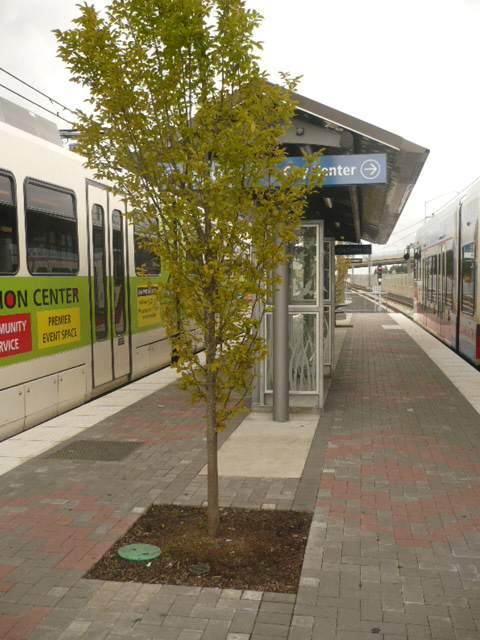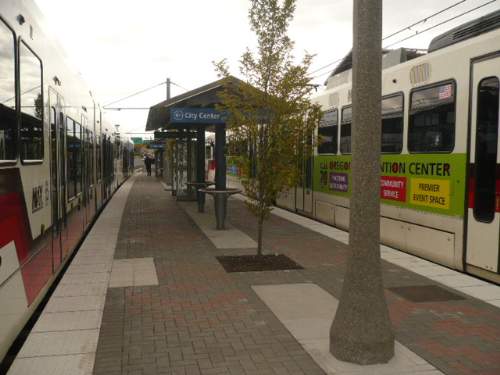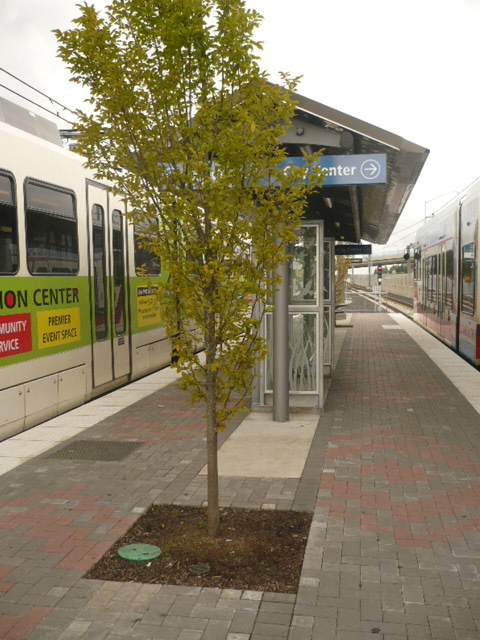
TriMet employees Jeff Johnson, a landscape maintenance professional with an arborist background, and Sean Batty, a landscape architect, were two of the biggest advocates for the presence of trees on the platforms. While the tree design was basically in place by the time Jeff came on board, he had a several goals in mind for the project overall:
- Varying tree species.
By varying the types of trees, TriMet could monitor which species were the most successful while allowing riders an easy way to visually differentiate the platforms .
- Making riders happy and comfortable.
The improvement of the lightrail system carried a significant cost — TriMet wanted to ensure that system patrons would be satisfied with the new platform design and knew that trees were a priority for Portland residents.
- Reducing noise pollution

The City of Portland, well-known for being friendly to the environment, has a requirement that more trees be planted than are removed. (Their canopy cover is somewhere above 26%, and they arecurrently working to increase it to 33%.) But they knew that tree planting alone wouldn’t be enough. They had to pay attention to how to plant them — specifically, pursuing design strategies and technologies that would provide them with conditions suitable to long-term growth and overall health. That’s where the Silva Cell, which was introduced to Johnson and Batty by a county partner, came in.
In addition to using the Silva Cell to provide adequate soil volumes on the lightrail platforms, Jeff and Sean decided to write their own contract with a plan for early tree procurement to local nurseries. The early procurement contract allowed them to inspect the trees prior to planting and ensure that the 3” caliper trees they intended to plant were healthy and good quality.
The trees on the seven light rail platforms are doing great, and TriMet has received a lot of positive rider feedback. Trees on light rail platforms face comparable stresses to trees planted on streetscapes — heavy pedestrian traffic, oceans of paving, and trash from daily wear and tear. Traditional transit platforms can be cold and sterile; by adding trees as a natural element the experience for riders is dramatically improved. Bolstered by appropriate rooting volumes, TriMet has created conditions for these trees to thrive, enabling them to act as windscreens, shelters, and generally desirable spots to wait for the train home to ferry you away. Similar transit systems should consider how including trees in their design plans can encourage ridership by making platforms more appealing, effective and comfortable for patrons.
Images: Jeff Johnson (thanks!)






This statement (copied below) in your article above is completely inacurate – vegetation does not mitigate noise
■Reducing noise pollution
The lightrail platforms are adjacent to a highway and can be quite noisy. Creating an environment where it was comfortable to wait was critical, and mature trees are very effective at mitigating noise
Hi Elizabeth,
My small amount of research suggested that vegetation can be an effective solution for noise mitigation. For example:
http://www.agroforestry.net/overstory/overstory60.html
http://www.forestresearch.gov.uk/fr/INFD-8AEFL5
Certainly, though, I am no expert in this. I also used Jeff Johnson’s anecdotal experience of the sound levels on the platform when writing this piece.
Digging further, I see that the Federal Highway Administration (FHWA) attributes approximately one to three decibels of noise reduction for every 100 feet of vegetation that is “sufficiently dense to completely block the view along the sound propagation path.” Delivering this level of noise reduction is achieved with “long, wide regions of heavy . . . woods and undergrowth, not just individual trees or several rows of trees.”
You’re right that in this scenario, the trees probably aren’t contributing significant reduction of noise levels. Still, cursory research indicates that there is evidence that vegetation — thoughtfully sited, sized and selected — can have this effect. Do you have other information about the noise reducing capacities of vegetation, or lack thereof, that you can point us to read more about? I’d love to educate myself about this further.
Have you calculated the stormwater treatment benefit of using the Silva cells?
Sorry, one more thought — if you’re curious about general stormwater treatment benefits, you may be interested in our Stormwater Estimating Worksheet
Hi Mark,
This was not a system that was designed to manage stormwater so — while there will certainly be some stormwater mitigation benefits due to there being larger trees and soil volumes on the light rail platforms — no formal calculations exist.
We are, however, doing monitoring for two stormwater installations at the moment:
1) The Marq2 streetscape in Minneapolis, MN (48 blocks)
2) The Queensway streetscape in Toronto, ON (1 block)
We should have data from those two projects by this fall. We’ll be sure to share what we learn on our blog as soon as it’s available.